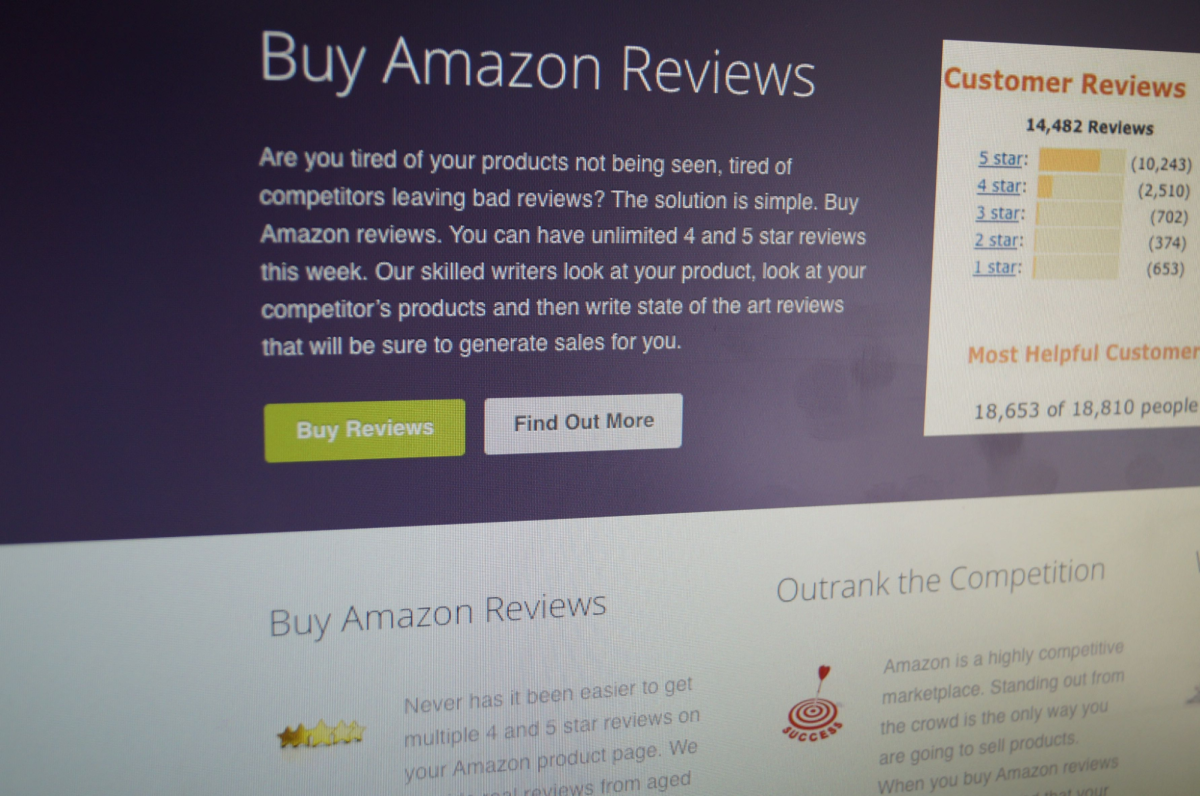310 million people use Amazon, and 1.6 million packages are delivered each and every day. Amazon is considered the most used shopping app ever, making its creator, Jeff Bezos, the second richest man in the entire world. Yet, with as much traction and attention as the site gets, Amazon has recently been exposed for being full of fake and AI-written reviews that cause customers to get scammed, lose trust in Amazon and sometimes even leave the site altogether.
Amazon is a shopping service that allows you to buy almost anything instantly and have it delivered within days. With shopping comes many reviews, and some people consider reviews to be the most important thing to look at. So, when Amazon was exposed for having fake reviews, it was a shock for many consumers. But what does a fake review even mean? Well, a fake review is a review that has been created for a product but fabricated by either an AI or a human who is getting paid to provide the review. It’s hard to tell who it’s truly written by, making it incredibly easy for scammers to write fake reviews. Yet, Youtuber “Mrwhostheboss” found a way to see completely through these. In his video “The Amazon Review Scandal,” he comes across a website selling fake reviews for people to purchase and place on any product they want.
Say you were making an iPhone charger and wanted to sell it on Amazon. An iPhone charger is a very basic product and has many different types of listings and brands producing it on Amazon. The competition is high for a product like that. So, a seller could potentially purchase fake negative reviews off of a site and place them on other competing products that aren’t theirs. The negative reviews come in huge batches, ultimately making the star rating of a competitive product go down, causing the original seller’s product to appear better or of higher quality. This is just one of the things that you can do on these websites. Based on an article written by Simon Hill on WIRED, positive reviews can also be easily fabricated using these websites. Rajvardhan Oak, a former writer and average Amazon user, found out that instead of using AI, scammers take a completely different approach.
“Over the following days, he saw a flood of similar Facebook ads, all with the same proposition: Buy a product, write a positive review, get a full refund, and the product is yours to keep,” Oak said after being interviewed by Simon Hill.
What these websites are pushing is way more sophisticated than originally thought. They push an ad out to millions of people online, trying to get you to buy a product and then write them a positive review. The reason why they ask this is because of how the Amazon reviews system works. Amazon automatically shows a symbol next to anyone who leaves a review after buying that specific product. This is their attempt at trying to stop false reviews. It hasn’t seemed to work, though, as the scammy websites are simply offering a refund to whoever leaves a positive review. This has very easily exploited Amazon’s system by leaving the reviewer with a verified buyer badge next to it and saving them 100% of their money. Win-win, right?
Well, sadly, yes. To this day, fake reviews still trick people, including innocent buyers like Micheal Dorrance, current father of three and a graphic designer, who was a real-life victim of these false reviews for fake products.
Dorrance was browsing the internet, searching for MacBook chargers. His original one had broken, so he had to look for a new one. Without it, he couldn’t do his work portably on his laptop, which would be a huge problem. Looking for cheaper options, Dorrance searched on Amazon. The site was flooded with dozens of cheap and affordable options, including one specific charger that claimed to be faster than Apple’s official brand while still being cheaper.
“I tried to look for an affordable charger, and managed to find one that was perfect for me. The product not only claimed to be great, but had reviews that were also backing the claims up. I read the good reviews and saw that it had a high star rating, so I bought it,” Dorrance said.
Days later, though, the product arrived at his door. And to his surprise, not only did the product feel cheap, but it didn’t even look like how it was presented in the photos provided on Amazon. According to Dorrance, the product only lasted about three weeks before completely dying out. The product was expected to last around a year, as marketed on the page. Not only was it an immediate disappointment, but it was also a very obvious scam.
“The charger wasn’t even being registered by the computer as a fast charger either. I got completely scammed. You hear about the review scams here and there, but you never truly believe in them or really pay much attention to them until they happen to you, too,” Dorrance said.
For now, these scam websites are still up and running, and ads for fake reviews are still going strong. So how in the world could an average shopper possibly know if a product is genuine or not based on reviews? Well, ever since the rise and awareness of these fake reviews and websites, there have been a couple of ways to check if a review is genuine. Visiting sites like ReviewMeta and Fakespot assists shoppers in truly figuring out if a product has real reviews or not. While this is a great step in the right direction, it still hasn’t completely solved the problem. Amazon hasn’t officially changed its system either, so until Amazon does something in the future, innocent customers will continue to get swindled and manipulated. Review scams can still be generated and created just as easily as they were before, and there’s no official way to tell if they are real or not except by relying on third-party websites and better judgment.








![When I chose to take a tour of the Old Joliet Prison in Joliet, IL, I had no idea what I was walking into. I’ve heard of multiple paranormal events happening here, but I was more interested in how a prisoner lived. I wanted to feel their hopelessness and wanted to understand what it must have been like to sit in an empty cell and yearn for sunlight.
The Old Joliet Prison is a daunting structure that appears, seemingly, out of nowhere. When driving to the prison, it isn’t until someone is a few feet away that they see the large walls and barbed wire. Just driving past it, they can feel a change in the atmosphere.
When a prisoner is being driven there, they don’t know how close they are. They are driving through a suburban neighborhood before they reach a small unassuming bridge. Yet, as soon as they go under the bridge and back into the sunlight, they finally see the prison and know that as soon as they go in, they will never come out.
“In 1878, the Prison was filled well over capacity with nearly 2,000 inmates,” according to jolietprison.org, a website that tells the history of the prison and allows for you to sign up for tours. “[There were] reports of unsanitary and dangerous conditions emerged.”
Throughout the state, people knew the allegations that staff was abusing the prisoners as well as killing them. Once a prisoner was told that they were going to Old Joliet Prison, they knew that it was a death sentence](https://kanelandkrier.com/wp-content/uploads/2024/07/prison1.jpg)
